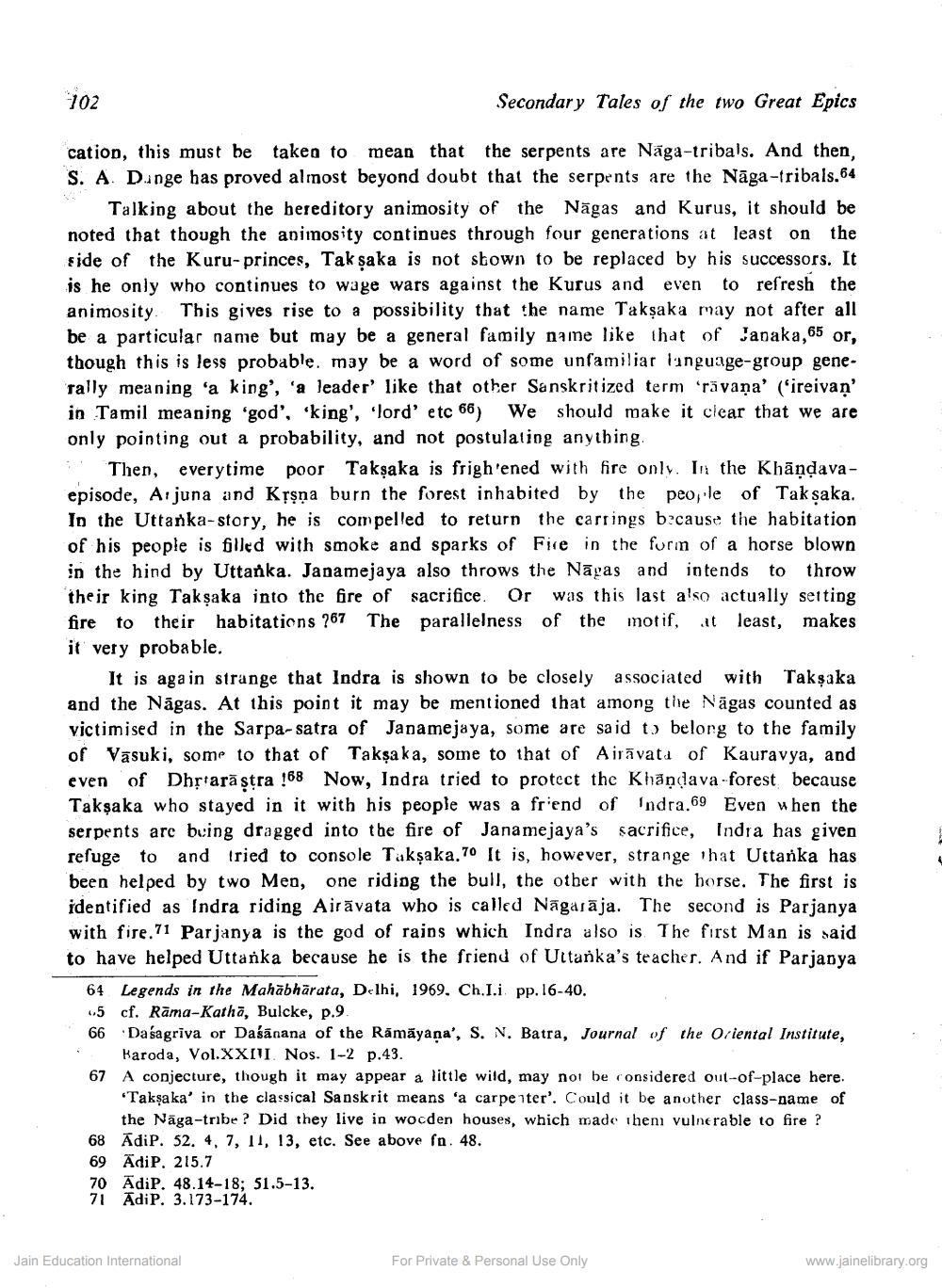________________
102
Secondary Tales of the two Great Epics
cation, this must be taken to mean that the serpents are Näga-tribals. And then, S. A Dinge has proved almost beyond doubt that the serpents are the Nāga-tribals.64
Talking about the bereditory animosity of the Nāgas and Kurus, it should be noted that though the animosity continues through four generations at least on the side of the Kuru-princes, Tak şaka is not shown to be replaced by his successors. It is he only who continues to wage wars against the Kurus and even to refresh the animosity. This gives rise to a possibility that the name Takşaka may not after all be a particular name but may be a general family name like that of Janaka,65 or, though this is less probable. may be a word of some unfamiliar language-group generally meaning 'a king', 'a leader' like that other Sanskritized term 'rāvana' ('ireivan in Tamil meaning 'god', 'king', 'lord' etc 66) We should make it clear that we are only pointing out a probability, and not postulating anything.
Then, everytime poor Takşaka is frigh'ened with fire only. In the Khāndavaepisode, Arjuna and Kļşņa burn the forest inhabited by the peo, le of Tak saka, In the Uttanka-story, he is compelled to return the carrings because the habitation of his people is filled with smoke and sparks of Fire in the furn of a horse blown in the hind by Uttanka. Janamejaya also throws the Nāgas and intends to throw their king Takşaka into the fire of sacrifice. Or was this last also actually setting fire to their habitations 267 The parallelness of the motif, at least, makes it very probable.
It is again strange that Indra is shown to be closely associated with Takşaka and the Nāgas. At this point it may be mentioned that among the Nāgas counted as victimised in the Sarpa-satra of Janamejaya, some are said to belong to the family of Vasuki, some to that of Takşaka, some to that of Airāvats of Kauravya, and even of Dhrasāstra !68 Now, Indra tried to protect the Khăņdava-forest because Takşaka who stayed in it with his people was a friend of Indra.69 Even when the serpents are buing dragged into the fire of Janamejaya's sacrifice, Indra has given refuge to and tried to console Takşaka.70 It is, however, strange that Uttarka has been helped by two Men, one riding the bull, the other with the horse. The first is identified as Indra riding Airāvata who is called Nāgarāja. The second is Parjanya with fire.71 Parjanya is the god of rains which Indra also is. The first Man is said to have helped Uttanka because he is the friend of Uttanka's teacher. And if Parjanya 64 Legends in the Mahābhārata, Delhi, 1969. Ch.I.i. pp. 16-40. ..5 cf. Rāma-Kathā, Bulcke, p.9. 66 Dasagrīva or Daśānana of the Rāmāyaṇa', S. N. Batra, Journal of the Oriental Institute,
Karoda, Vol. XXIII. Nos. 1-2 p.43. 67 A conjecture, though it may appear a little wild, may not be considered out-of-place here.
"Takşaka' in the classical Sanskrit means 'a carpenter'. Could it be another class-name of
the Nāga-tribe ? Did they live in wocden houses, which made them vulnerable to fire ? 68 AdiP. 52. 4, 7, 11, 13, etc. See above fn. 48. 69 AdiP. 215.7 70 AdiP. 48.14-18; 51.5-13. 71 AdiP. 3.173-174.
Jain Education International
For Private & Personal Use Only
www.jainelibrary.org




